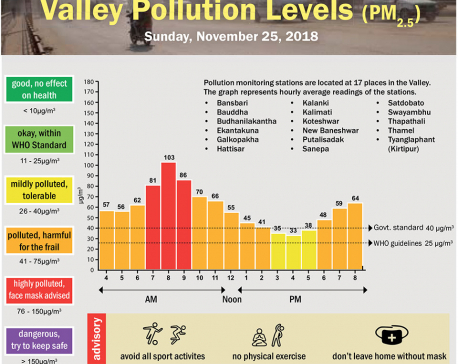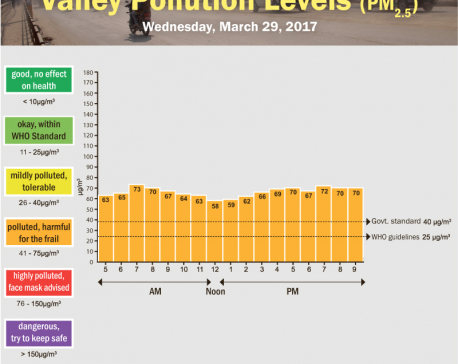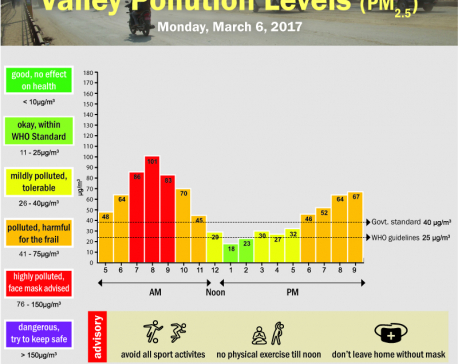
OR
Political will stressed for tackling Valley pollution
Published On: February 7, 2017 12:50 AM NPT By: Ram Saran Tamang
PM 2.5 and smaller fine particles can be inhaled and become lodged in the lungs and then in the blood vessels
KATHMANDU, Feb 7: About 40,000 people suffer from cancer every year in Nepal while 10,000 cancer patients die annually, claimed Dr Budhi Ratna Khadkey, secretary of Nepal Academy of Science and Technology (NAST), citing their 10 years of research.
"And air pollution may be one of the most important factors causing cancer. The research has shown that air in Kathmandu is highly carcinogenic as exposure to the capital's air can raise the risk of cancer by about 40 percent," he said, speaking at 'Meet your Scientists' function organized at NAST on Monday.
However, the burning issue of air pollution can be tackled, echoed the team of specialists from various disciplines. Doctors, scientists, and government officials among other stakeholders of the related field attended and shared their views at the function organized on the topic of 'Air pollution, its health implications and solutions'.
Minister for Health Gagan Thapa admitted weaknesses in some of the government's policies which he said have contributed to the problem of air pollution.
"At present, the pipe-laying work of the Melamchi Water Supply Project is one of the major contributors of dust and air pollution in Kathmandu Valley. Although MSWP's work is almost complete, the government's sewage project would immediately start, preventing the valley's denizens from respite from dusts," he said, stressing better coordination among multiple departments of the government to tackle the air quality issues.
Minister Thapa further said that tackling air pollution requires tough decisions, such as commitment to ban diesel and petrol vehicles by another decade. "Such decisions are tough but must be made."
Dr Khem Bahadur Karki, member-secretary of Nepal Health Research Council, highlighted some of the health issues caused by air pollution and warned that there would be public health emergency in the next 2-4 years if the current level of pollution continues unchecked.
"Air in the valley contains Particulate Matters (PM) of diameter less than 2.5 micrometers. PM 2.5 and smaller fine particles can be inhaled and become lodged in the lungs and then in the blood vessels, leading to serious health hazards," he said.
According to him, strong backing from political parties is crucial in order to tackle air pollution. "We have to minimize sources of air pollution first. Without political will, we are helpless. Even the provision to ban vehicles of 20 years and older will not succeed without it," added Dr. Karki.
Bhupesh Adhikari, senior air quality specialist of ICIMOD, also offered some insights into air pollution, and said that others cities have solved its pollution problems and Kathmandu too can do it.
You May Like This

Valley Pollution Levels for November 25, 2018
Valley Pollution Levels for November 25, 2018 ... Read More...

Valley Pollution Levels
The graph above is based on the pollutant of fine particulate matter, PM2.5 (PM less than 2.5 microns) of Kathmandu... Read More...

Valley Pollution Levels
The graph above is based on the pollutant of fine particulate matter, PM2.5 (PM less than 2.5 microns) of Kathmandu... Read More...







Just In
- NRB to provide collateral-free loans to foreign employment seekers
- NEB to publish Grade 12 results next week
- Body handover begins; Relatives remain dissatisfied with insurance, compensation amount
- NC defers its plan to join Koshi govt
- NRB to review microfinance loan interest rate
- 134 dead in floods and landslides since onset of monsoon this year
- Mahakali Irrigation Project sees only 22 percent physical progress in 18 years
- Singapore now holds world's most powerful passport; Nepal stays at 98th











Leave A Comment